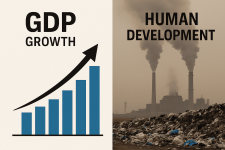In 2025, GDP growth still dominates headlines, often seen as the ultimate symbol of a nation's prosperity. But let’s pause and ask—does a booming GDP automatically mean a better life for all?
India’s economy grew by 7.8% last year, placing it among the fastest-growing globally. Yet for many, the gains felt abstract. Rising inequality, public health crises, and environmental stressors tell a different story. GDP may measure economic output—but not happiness, health, education, or equity. It’s time to rethink what progress truly means.
Gross Domestic Product measures the total value of goods and services produced. While it offers a snapshot of economic performance, it's silent on who benefits. Two countries might boast identical GDPs, yet one may suffer from widespread poverty while the other enjoys robust public services and high life expectancy.
GDP ignores nuances: unpaid care work, mental health burdens, or the ecological cost of growth. For example, mining activities may boost GDP in the short run—but leave behind irreparable environmental damage and displaced communities.
Policies built around GDP alone can misfire. Infrastructure mega-projects may fuel growth yet displace thousands. Tax reforms focused solely on maximizing revenue might overlook their regressive impact on low-income groups.
Moreover, in a world grappling with climate change, economic growth that exhausts natural resources is unsustainable. A country’s rising GDP may coexist with deteriorating air quality, rising suicide rates, or widespread job insecurity—realities GDP doesn’t flag.
Thankfully, alternative metrics are gaining traction:
These models recognize that progress should be about people, not just profits.
As a researcher focused on life expectancy prediction using GDP and population data, I’ve seen firsthand how machine learning can uncover hidden disparities—where nations with similar GDPs diverge sharply in public health outcomes. It’s a reminder that numbers should empower equity, not obscure it.
GDP isn't obsolete—but it’s incomplete. In 2025, a truly “developed” nation is one where citizens live long, healthy lives with dignity, in harmony with their environment. As data becomes more sophisticated and accessible, our metrics must evolve too.
If growth doesn’t serve the people, is it really progress?
India’s economy grew by 7.8% last year, placing it among the fastest-growing globally. Yet for many, the gains felt abstract. Rising inequality, public health crises, and environmental stressors tell a different story. GDP may measure economic output—but not happiness, health, education, or equity. It’s time to rethink what progress truly means.
 The GDP Illusion
The GDP Illusion
Gross Domestic Product measures the total value of goods and services produced. While it offers a snapshot of economic performance, it's silent on who benefits. Two countries might boast identical GDPs, yet one may suffer from widespread poverty while the other enjoys robust public services and high life expectancy.
GDP ignores nuances: unpaid care work, mental health burdens, or the ecological cost of growth. For example, mining activities may boost GDP in the short run—but leave behind irreparable environmental damage and displaced communities.
 What’s at Stake?
What’s at Stake?
Policies built around GDP alone can misfire. Infrastructure mega-projects may fuel growth yet displace thousands. Tax reforms focused solely on maximizing revenue might overlook their regressive impact on low-income groups.
Moreover, in a world grappling with climate change, economic growth that exhausts natural resources is unsustainable. A country’s rising GDP may coexist with deteriorating air quality, rising suicide rates, or widespread job insecurity—realities GDP doesn’t flag.
 The Shift Toward Holistic Indicators
The Shift Toward Holistic Indicators
Thankfully, alternative metrics are gaining traction:
- Human Development Index (HDI) includes life expectancy, education, and income.
- Gross National Happiness (GNH), pioneered by Bhutan, centers psychological well-being, cultural preservation, and ecological sustainability.
- Social Progress Index (SPI) ranks countries by basic human needs, well-being, and opportunity.
These models recognize that progress should be about people, not just profits.
As a researcher focused on life expectancy prediction using GDP and population data, I’ve seen firsthand how machine learning can uncover hidden disparities—where nations with similar GDPs diverge sharply in public health outcomes. It’s a reminder that numbers should empower equity, not obscure it.
 Looking Ahead
Looking Ahead
GDP isn't obsolete—but it’s incomplete. In 2025, a truly “developed” nation is one where citizens live long, healthy lives with dignity, in harmony with their environment. As data becomes more sophisticated and accessible, our metrics must evolve too.
If growth doesn’t serve the people, is it really progress?

